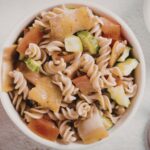
Fiber is an important dietary component found in plants, such as whole grains, beans, legumes, nuts, fruits, and vegetables. It’s essential for efficient digestion, blood glucose management, and satiation.
It’s recommended that the average adult consumes 30 grams of fiber a day. The average intake is less than this, meaning many people aren’t reaping the benefits of adequate fiber intake.
In this article, we will discuss why fiber is so important and the meals and snacks rich in fiber to add into your diet to achieve the recommended daily intake.
Why Fiber is So Important
Consuming adequate amounts of fiber (both soluble and insoluble) is essential for great overall health. Here’s why.
Digestive Health and Function
Fiber promotes great digestive health in a number of ways. It bulks up the stool, making it easier to pass and preventing constipation.

Soluble fiber slows down digestion and absorption of nutrients, helping to stabilize the blood sugar level after meals and lowering the risk of type 2 diabetes. It gets fermented by the gut bacteria to produce beneficial nutrients and promote optimal digestive health.
Lower Risk of Chronic Diseases
Fibre can help to lower the risk of several chronic diseases, including cardiovascular disease, type 2 diabetes, and even some types of cancer. It does so by lowering inflammation and blood cholesterol levels, promoting better overall health and well-being.
Better Heart Health
The consumption of fiber-rich foods, especially those high in soluble fiber, can improve cardiovascular health by lowering blood pressure and blood cholesterol levels. A high-fiber diet is associated with healthier blood pressure and a lower risk of heart disease.
Weight Management
Consuming a high-fiber meal can increase satiation and stabilize blood glucose, leaving you feeling fuller for longer.

As a result, you’re less likely to reach for snacks in between meals and overconsume calories, making it easier to lose weight or maintain your weight.
How to Increase Your Fiber Intake
Here are foods that are high in fiber to include in your diet when you want to increase your fiber intake.
Whole Grains
Whole grains, such as whole wheat pasta, wholegrain bread, brown rice, and oats, are higher in fiber than white grains. Simply switch your white grains for wholegrain alternatives, and you can increase your daily fiber intake without making drastic changes to your diet.
Fruits and Vegetables
Fruits and vegetables are packed full of fiber. The skins of fruits tend to contain a large proportion of the total fiber in the fruits, so keep the skins on when you’re trying to boost your overall fiber intake. Consider making fruit smoothies, stirring mixed vegetables to your meals, or snacking on veggie sticks and dips.
Legumes and Beans
Lentils, chickpeas, and beans are great foods to include in your diet if you’re trying to reach the daily 30-gram fiber intake recommendation. Use lentils to make curry, chickpeas to make falafel, and beans to bake bean burgers. Alternatively, add chickpeas or beans to your salads for a fiber-rich lunch.






